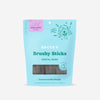
It’s no secret that dogs love to go outside and explore the abundance of nature around them. But studies show that not every outdoor plant is safe for dogs to sniff out. Which plants are unsafe for dogs to explore and how can we protect our pets? Let’s find out.
Flowers
While it may be cute to see our dogs roam around in a flower bed, not all flowers are safe for dogs to eat. Flowers like chrysanthemums, daffodils, irises, and lilies can be harmful to your dog’s digestive system and cause vomiting and diarrhea. Other beautiful flowers such as foxgloves and tulips can be especially harmful to dogs and impact cardiovascular health. If you are an avid gardener, it’s recommended that you put restrictions around flower beds to prevent your dog from getting into them freely.
Shrubs
Some shrubs, such as holly, hydrangea, and peonies, contain a toxin that can cause gastrointestinal problems. Ingesting other shrubbery, like ivy and sago palm, can cause side effects like vomiting, diarrhea, a swollen mouth and tongue, and difficulty breathing.
Trees
While you and your dog may love lounging on a picnic blanket underneath a shady tree, some trees and the seeds that they produce can be harmful to dogs. The Chinaberry and Japanese Yew trees can result in fatal symptoms for dogs, while other trees, like the Black Walnut tree, can cause more mild side effects. Fruit seeds from plums, apricots, and peaches contain toxins that can make your dog sick, while nut trees leave behind seeds that can get stuck in a dog’s gastrointestinal system. It is important to consistently sweep up leaves and seeds in the fall, as well as frequently monitor the areas around trees for anything that might be dangerous to your dog.
If your dog exhibits any symptoms or unusual behaviors after spending time outdoors, contact a vet right away. With the right attention and care, your dog will be able to enjoy the great outdoors safely.



